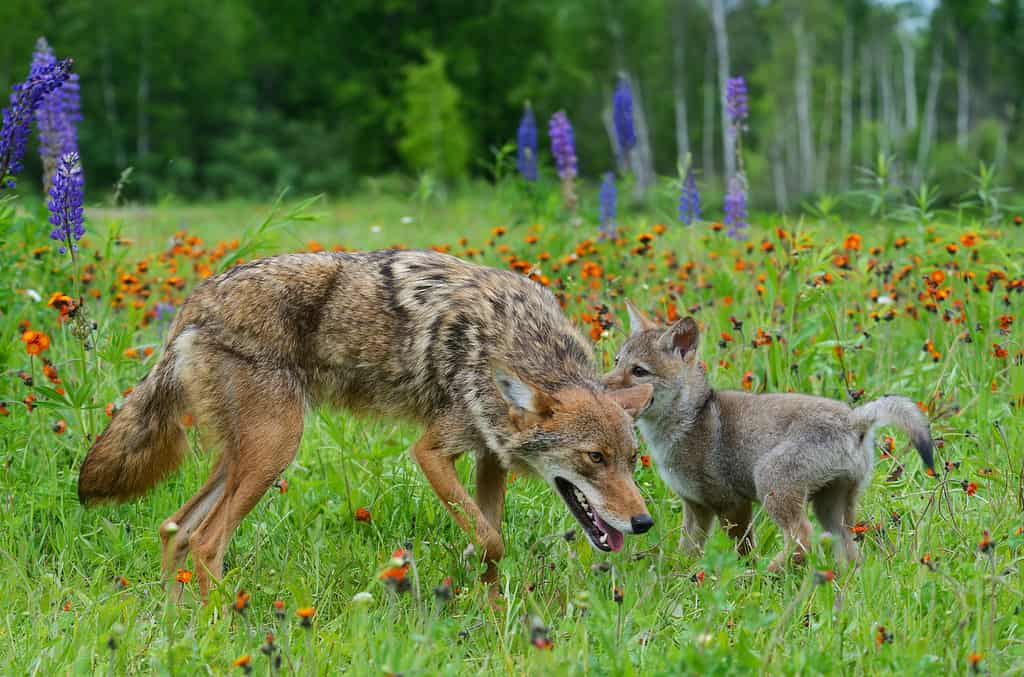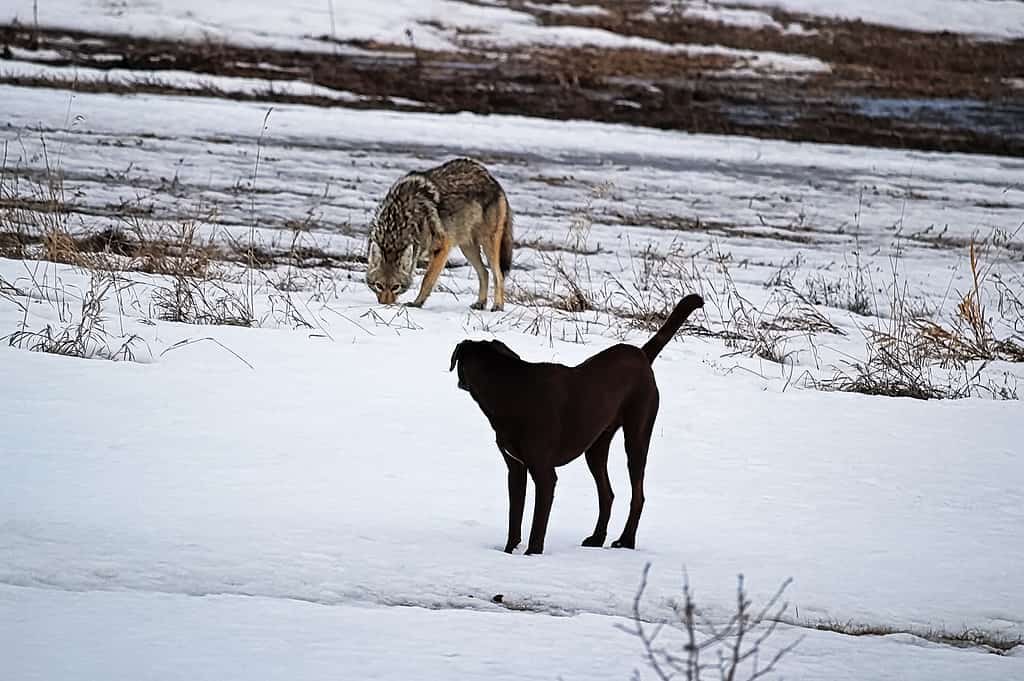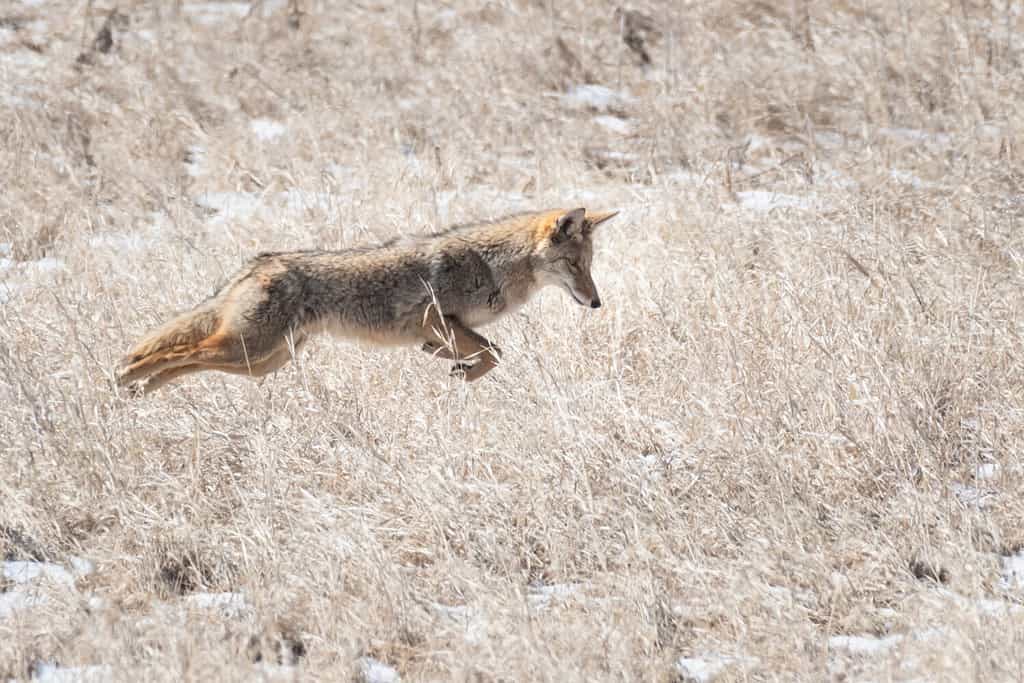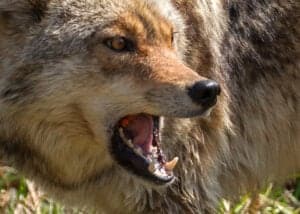Folklore and movies have often depicted coyotes howling at a full moon. Much like werewolves, they are portrayed as feared, misunderstood, and affected by lunar cycles.
As coyote territory expands and they increasingly overlap with people in suburban and urban areas, misinformation has become rampant. Many people see coyotes as a threat to themselves, their children, their livestock, or their pets. As a result, the misunderstood coyote has suffered. Over half a million coyotes are slaughtered every year in the United States. Aerial gunning, trapping, shooting, and poisoning are all used to kill coyotes indiscriminately.
Combatting the stereotypes and false information about coyotes is the first step in protecting this clever, adaptable species. Let’s take a look at five coyote myths and the fallacies behind them.
1. Coyotes Howl at the Moon

While coyotes don’t howl at the moon, the status of the moon can affect their vocalizations.
©alby85/iStock via Getty Images
Contrary to popular belief, coyotes do not howl at the moon. The myth of coyotes howling at the moon probably stems from the fact that they are most active when it is dark. Coyotes can be either diurnal (active at dusk and dawn) or nocturnal (active at night), depending on their environment. Since they are awake when it’s dark, they are more vocal at that time. As a result, folklore depicts the animals as reacting to the moon.
While they don’t howl at the moon, the status of the moon can affect their vocalizations. They actually may howl less on nights with full moons! One study found that howling had a negative correlation with increased moonlight and that coyotes vocalized more with one another on darker nights. This finding makes sense since coyotes howl to communicate with other pack members, establish and defend territory, or warn other coyotes that they are not welcome.
When it is darker and visibility isn’t as good, sound becomes a more valuable communication tool. Coyotes have good night vision and often prefer to hunt on darker nights when it is easier to sneak up on unsuspecting prey. When coyotes hunt, they howl to communicate their position to other pack members.
And coyotes like to communicate. Sometimes called the “song dog,” coyotes are one of North America’s most vocal animals. They have a range of vocalizations, from howls and growls to high-pitched barks, yips, and yelps. The sound of their howls can be heard from great distances — sometimes as far as several miles away.
2. Coyotes Are Dangerous

An average coyote litter size is anywhere between four and seven pups.
©Betty4240/iStock via Getty Images
Much like wolves, coyotes are believed to be dangerous and pose threats to people. In actuality, the opposite is true. Coyotes are shy animals that prefer to stay away from people. While all wild animals should be treated cautiously and with respect, coyotes do not pose much danger to humans. From 1960 to 2006, there were 159 confirmed instances of a coyote biting a person in North America, according to the Urban Coyote Project. This adds up to fewer than four bites per year. The bites were almost evenly spread between adults and children, negating the myth that children are more at risk of coyote attacks. Considering that coyotes are found in 49 U.S. states and across Canada, bite incidences are incredibly rare. In comparison, 4.5 million people are bitten by dogs every year in the United States.
With 579 million people and an estimated 1 million to 10 million coyotes in North America, coyote attacks are bound to happen occasionally. However, there are several easy steps people can take to reduce the likelihood of a coyote conflict. The most effective way to prevent coyote attacks is to not feed them. When humans feed coyotes, the animals lose their natural fear of people and can become bold in demanding food. This can also bring coyotes into closer contact with household pets.
Dangers to Dogs and Cats
Coyotes prefer smaller prey and will avoid interactions with most dogs. They typically weigh between 20 to 50 pounds and are usually only about half the size of an average Labrador retriever. Since up to 70% of a coyote’s diet is made up of small mammals such as rabbits, squirrels, and rats, most coyotes are not looking for the trouble of catching a large meal like a dog. The coyote’s preferred prey animals generally weigh one to four pounds.
However, small breeds such as chihuahuas or Yorkshire terriers that are similar in size to squirrels or rabbits may be at risk since they look like prey. Small cats can also resemble one of the coyote’s preferred meals. The best way to protect your pets from coyotes is to be aware and keep cats inside. Small dogs should be supervised if let out at night. Don’t let pets run loose and never leave small pets tied up alone outside after dark. Remember, coyotes generally avoid human contact, so if a person is with a small dog, the coyote is much less likely to approach. By being vigilant, coyote attacks on small pets can be prevented.
3. They Lure Pets Away to Attack

Coyotes are unlikely to engage with domestic dogs that are their size or larger.
©Akchamczuk/iStock via Getty Images
Another coyote myth prevalent on social media is that they will lure domestic dogs away from home to ambush and kill them. In reality, situations where dogs follow and then are injured by coyotes are usually just that: The dog is interested in the coyote, the coyote leaves to return to its pack, and the dog follows it. Coyotes return to their packs if they feel threatened, so a dog following a coyote may come into contact with other coyotes. While this may seem like a premeditated plan on the part of the coyotes, it’s actually the dog that has put itself into a situation where it is outnumbered.
Additionally, coyotes do not use pack members as bait to lure dogs. Coyotes are protective of their families and do not want to put them at risk. If a dog threatens a coyote though, its family may move to protect it.
4. Coyotes Are as Big as Wolves

There are 19 subspecies of coyotes in North America.
©Steve Byland/Shutterstock.com
When something seems scary, we often imagine it to be bigger than it actually is. However, coyotes are not as big as many people think. One coyote myth is that they are as big as wolves. In actuality, the North American gray wolf is about double the size of a coyote.
Grey wolves weigh 70-100 pounds, measure up to 6 feet in length, and stand around 2.5 feet tall. Conversely, coyotes weigh 20-50 pounds, are 4 feet in length, and are only 1.5 feet tall. Even their paws are half the size of a gray wolf’s.
This means the coyote is also only about half the size of a domestic German shepherd or golden retriever. While they are smaller than many Canis species, coyotes are about twice as large as foxes.
5. They Are Bad to Have Around

Coyotes are great jumpers and can jump up to 12 feet horizontally.
©Eivor Kuchta/Shutterstock.com
Coyote populations flourished after humans exterminated almost all of the wolves in North America. Once the wolves were gone, the coyotes adopted their place in the food chain and are now the apex predators in many places.
As predators, coyotes play an important role in the ecosystem. They weed out sick or injured animals to keep populations healthy and strong. Coyotes eat vermin like rats, mice, and other small animals people consider pests. This helps in suburban areas by reducing the need for pest control and lowering the risk of rodent-borne disease.
Coyotes are also beneficial in rural areas. On farms, coyotes prevent crop loss by eating rodents that damage crops. While ranchers generally dislike coyotes, the animal is beneficial on ranch land as well. There, they control populations of rabbits, gophers, and other small herbivores that compete for food sources with grazing animals like horses and cows.
The coyote also keeps populations of smaller predators and omnivores (such as raccoons, skunks, and foxes) in check, which boosts biodiversity and ensures ecosystems remain balanced. They are also nature’s garbage collectors. As scavengers, coyotes eat carrion, which helps keep environments clean.
Ultimately, coyotes are critical to our ecosystems, and misconceptions that result in violence against coyotes hurt everyone. By understanding the benefits of these shy animals, people can learn the importance of coexisting with coyotes.
Summary of Coyote Myths
| Coyote Myth | Truth |
|---|---|
| Coyotes howl at the moon | Coyote howling is not linked to lunar cycles. Coyotes are most active at night and vocalize more when it is dark. |
| Coyotes are dangerous | Attacks against people are incredibly rare, and keeping an eye on pets can keep them safe from coyotes. |
| They lure pets away to attack | Coyotes return to their packs when they feel threatened, so a dog chasing a coyote may find itself outnumbered. |
| Coyotes are as big as wolves | Wolves are twice the size of coyotes. |
| They are bad to have around | Coyotes play an important role in managing rodent populations and maintaining biodiversity. |
The photo featured at the top of this post is © © Getty Images/PHOTOS.com>> via Getty Images
Thank you for reading! Have some feedback for us? Contact the AZ Animals editorial team.







